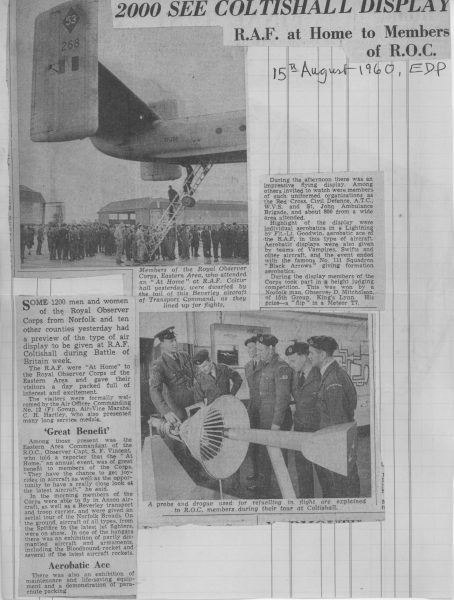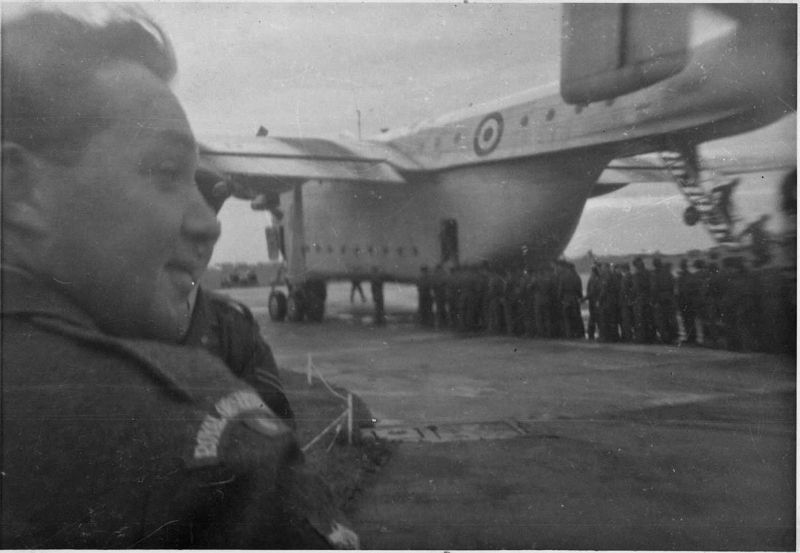Beverley – a day to remember …
Looking through some old newspaper cuttings recently, and seeing photos that went with it, I was reminded of my first flight in August 1960.
I had joined the Royal Observer Corps (ROC) in 1959 aged 15, one year before the joining age (because I was good at aircraft recognition). Without the ROC manning aircraft observation posts that were five to eight miles apart at that time, the RAF would have been unable to carry out air defence of Great Britain exercises such as “Divided”.
We practised low flying exercises when “enemy” aircraft, “Rats” were NATO, American or one or two RAF types, i.e. Canberras. Normally in our area, they were Thunderstreaks of the Dutch Air Force, and the defending fighters were “Terriers” usually Hunter F6s of 74 Squadron. On these exercises, we would report all military and civil aircraft from contrail to ground level.
Crews and posts were trained to a high standard using the ROC Recognition Journal, Identification cards, 3-view and photos and aircraft models hanging from our training room ceiling. The best being the “flash trainer”, a slide projector with a camera type lens, we would train at 100th of a second. This could well be the time you saw an aircraft passing between clouds. When we went into inter post and group competitions you saw slides for 1 second, the final ten for 10th of a second, after the training this was a doddle.
As a thank you the RAF held ROC “at home” days. Until the mid-1960s these were held at RAF Horsham St Faiths, but this year it was at RAF Coltishall.
Our post crew from Delta Wun at Loddon all went. It was attended by 1,200 observers. We were greeted in the hangar by speeches from Air Officer Commanding, No 12 (Fighter) Group, Air Vice Marshall C. H. Hartley and Eastern Area Commander, Observer Captain S. F. Vincent. Long service medals were presented for 12 years service. We were then free to look at displays in the hangars, look around the static park (no barriers) and put our names down for flights.
The hangar displays included food and drink, ejector seats. We were trained what to do in the event of an aircraft force-landing near our posts, how to open canopies, or smash them with an axe, not to touch anything yellow and black, where to put the pins in the seat to make them safe and how to get the crew out. There were also radio displays, Rations and Emergency equipment such as rafts, aircraft under maintenance, Jet engines and a World War II German Storch aircraft (the swastika from this is on display in room 3).
The star of the static park was Lightning F.1 XM138 coded G of the air Fighter Development Squadron based at RAF Coltishall. There were two spitfires (one static, one flew), a Meteor F.4 in No 245 Squadron markings, Meteor F(TT).8 WL164 target tug, Anson C.19, Swift of No 2 Squadron from RAF Germany, Two Hunters of No 74 Squadron (an F.6 and T.7) and two Javelins of No 23 Squadron, one armed with four Firestreak missiles the other an FAW.9R with four long-range tanks and refuelling probe. These two latter had RAF “guards” who would not let us take photos of either.
It was time for our post crew to get into the queue for flights. Ivan Carpenter was with me, due to fly in the Beverley. The others went in an Anson C.19. The photo in the EDP was taken at the same time that I took one of Ivan in front of me from the other direction. The aircraft was Beverley C.1 XB268 of No 53 Squadron. Once the ROC passengers had de-planed from the fuselage and tail the ones going in the fuselage got on board, then it was out turn to climb the ladder into the tail. We belted up then one of the crew climbed up the roof hatch to look out and guide the pilots, the props were put into reverse, and we reversed out of the dispersal near the control tower, then forwards on the perimeter track, past the hangars to the end of the runway. Sitting on the port side just behind and above the wing, I guess around 20′ above the runway, I was looking at the fuel and disused bomb dump. The engines revved and we picked up speed and for a large aeroplane were soon airborne. (At this time it was the largest aeroplane in the RAF.)
Gaining height we headed for the coast, looking at the broads and the towns and villages below. Over the coast we headed North along the coast, we turned overhead Trimmingham Radar Station and started the approach run to RAF Coltishall again. Seconds before landing the engine note changed, the props had been put into reverse for a short landing, we soon came to a stop, reversed back along the runway then taxied back to the same dispersal.
In the afternoon we were treated to an air show. This included a Lincoln, LABS Canberra, Hunters, Javelins and a Meteor for the height judging competition. The prize for this was a flight in a Meteor T.7. A Whirlwind helicopter also did an Air Sea Rescue demonstration. What a day for a 16-year-old!
The photo that I took of the Beverley was taken with a cheap sixty-year-old pocket camera.
As soon as our daughter was 16 she joined crew 3 ROC at Norwich, doing all the jobs, Display A, Display B, Log charts and Teller. She was good as a plotter where lads on posts would “chat her up”, and she was invited to visit some of the posts such as Wymondham and Corton underground posts. Josie and I would go along to do the driving and talk to the crews. At Corton post, she was presented with the plotter of the year trophy (on display in the ROC museum). (Beverley is a founder member of the museum, she was happy as a youngster cleaning early wreckology bits and pieces, engines, etc. She also presented W/C Ken Wallis with a painting of a Lysander by John Reeve when he opened our Nissen hut museum in 1976). Beverley’s husband was Chief Observer on the Thetford post.
Author:: Huby Fairhead

NASAM Needs Your Help … Donate or Membership, which is for you ??
If you would like to help the Museum please consider either a donation, which can be done via any of the purple “DONATE NOW” buttons on the blog. Alternatively, to help longer-term and stay in touch with what is happening at NASAM why not take out a membership to the museum. For more details please follow this link Become a Museum Member
Follow us on Social Media, email us or visit our Main Website.


